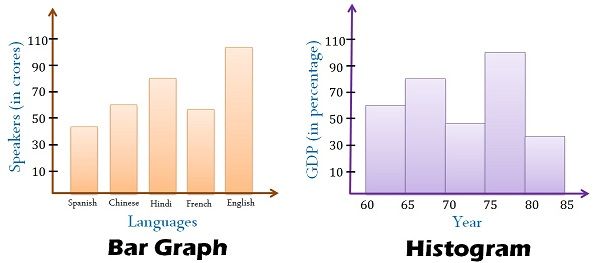Difference Between Histogram And Bar Chart . The histogram is drawn in such a way that there is no gap between the bars. About press copyright contact us creators advertise developers terms privacy policy & safety how youtube works test new features press copyright contact us creators.
Bar Chart Vs Histogram - Edraw from www.edrawsoft.com
Conversely, a bar graph is a diagrammatic comparison of discrete variables. In statistics, summarizing and presentation of the data is important. The main visual differences between a histogram and a bar chart are:
Bar Chart Vs Histogram - Edraw Histogram refers to a graphical (or statistical) representation; A pareto chart uses a line to represent cumulative frequencies of each bar. Histograms visualize quantitative data or numerical data whereas bar charts display categorical variables. Histogram presents numerical data whereas bar graph shows categorical data.
Source: www.syncfusion.com A bar graph is the graphical representation of categorical data using rectangular bars where the length of each bar is proportional to the value they represent. In bar charts, the groups are typically categorical variables. Q #6) what does each bar in a histogram represent? Column charts or bar charts are used to compare values across different categories. However, the.
Source: www.storytellingwithdata.com Q #6) what does each bar in a histogram represent? A histogram is the graphical representation of data where data is grouped into continuous number ranges and each range corresponds to a vertical bar. For a review of all these chart types and more, consider reading: In a histogram there is no gap between bars, while the bar chart has.
Source: keydifferences.com Column charts are most often used to emphasize changes over time or for comparison of items or categories. Firstly, a bar chart displays and compares categorical data, while a histogram accurately shows the distribution of quantitative data. Q #6) what does each bar in a histogram represent? For a review of all these chart types and more, consider reading: Both.
Source: www.storytellingwithdata.com Column charts are most often used to emphasize changes over time or for comparison of items or categories. Both of them are also different as bars in histograms are connected and may have different widths, whereas bars in bar charts are not. Conversely, a histogram does not use any such line. (image will be uploaded soon) histogram basically refers to.
Source: www.syncfusion.com Histogram presents numerical data whereas bar graph shows categorical data. Column charts are most often used to emphasize changes over time or for comparison of items or categories. Histogram refers to a type of bar chart that is used to represent statistical information by way of bars, to show the frequency of continuous data. Histogram presents numerical data whereas bar.
Source: www.cuemath.com What is the difference among histogram, bar chart, pie chart? Both of them are also different as bars in histograms are connected and may have different widths, whereas bars in bar charts are not. A histogram, on the other hand, is a type of chart that evaluates frequency data. A histogram represents the frequency distribution of continuous variables. In statistics,.
Source: www.youtube.com Most of the time, this rule holds true. About press copyright contact us creators advertise developers terms privacy policy & safety how youtube works test new features press copyright contact us creators. However, the only difference between the two is that in a bar chart the bars are horizontally aligned, whereas when the bars are vertically aligned, it is known.
Source: www.edrawsoft.com About press copyright contact us creators advertise developers terms privacy policy & safety how youtube works test new features press copyright contact us creators. What is the difference among histogram, bar chart, pie chart? In bar charts, the groups are typically categorical variables. Histogram refers to a type of bar chart that is used to represent statistical information by way.
Source: www.storytellingwithdata.com That displays data by way of bars to show the frequency of numerical data. Histogram presents numerical data whereas bar graph shows categorical data. Column charts or bar charts are used to compare values across different categories. The main visual differences between a histogram and a bar chart are: Each bar represents the frequency of occurrence of the data interval.
Source: www.teachoo.com A pareto chart uses a line to represent cumulative frequencies of each bar. The main visual differences between a histogram and a bar chart are: In bar charts, the groups are typically categorical variables. That displays data by way of bars to show the frequency of numerical data. In a histogram there is no gap between bars, while the bar.
Source: chartio.com A bar graph is the graphical representation of categorical data using rectangular bars where the length of each bar is proportional to the value they represent. (image will be uploaded soon) histogram basically refers to a graphical representation; Histograms are a bunch of bars connected to each other, visualizing a distribution of a some continuous quantitative variable. That displays data.
Source: keydifferences.com Both of them are also different as bars in histograms are connected and may have different widths, whereas bars in bar charts are not. However, the only difference between the two is that in a bar chart the bars are horizontally aligned, whereas when the bars are vertically aligned, it is known as a column chart. Conversely, a bar graph.
Source: www.kaggle.com A histogram is the graphical representation of data where data is grouped into continuous number ranges and each range corresponds to a vertical bar. Histogram presents numerical data whereas bar graph shows categorical data. In most instances, the numerical data in a histogram will be continuous (having infinite values). However, the only difference between the two is that in a.
Source: www.qimacros.com Histogram presents numerical data whereas bar graph shows categorical data. Firstly, a bar chart displays and compares categorical data, while a histogram accurately shows the distribution of quantitative data. Both of them are also different as bars in histograms are connected and may have different widths, whereas bars in bar charts are not. In a histogram there is no gap.
Source: www.exceldemy.com A pareto chart uses a line to represent cumulative frequencies of each bar. Histogram presents numerical data whereas bar graph shows categorical data. Key difference between bar graphs and histogram (bar graph vs histogram) bar graph vs histogram can be drawn clearly on the following grounds given below: A histogram represents the frequency distribution of continuous variables. Unlike bar charts.
Source: www.quora.com A histogram represents the frequency distribution of continuous variables. In bar charts, the groups are typically categorical variables. A pareto chart uses a line to represent cumulative frequencies of each bar. The histogram is drawn in such a way that there is no gap between the bars. Conversely, a bar graph is a diagrammatic comparison of discrete variables.
Source: medium.com Column charts or bar charts are used to compare values across different categories. The histogram is drawn in such a way that there is no gap between the bars. (image will be uploaded soon) histogram basically refers to a graphical representation; Conversely, a bar graph is a diagrammatic comparison of discrete variables. That displays data by way of bars to.
Source: keydifferences.com Column charts or bar charts are used to compare values across different categories. Since they vary in purpose, they plot data in different ways. Visual difference between histogram and bar charts. Unlike bar charts that present distinct variables, the elements in a histogram are grouped together and are considered ranges. Histogram refers to a type of bar chart that is.
Source: www.statisticsfromatoz.com The main visual differences between a histogram and a bar chart are: That displays data by way of bars to show the frequency of numerical data. However, the only difference between the two is that in a bar chart the bars are horizontally aligned, whereas when the bars are vertically aligned, it is known as a column chart. A pareto.
Source: www.kaggle.com Visual difference between histogram and bar charts. A histogram is the graphical representation of data where data is grouped into continuous number ranges and each range corresponds to a vertical bar. Since they vary in purpose, they plot data in different ways. A pareto chart uses a line to represent cumulative frequencies of each bar. Both charts display a summary.

